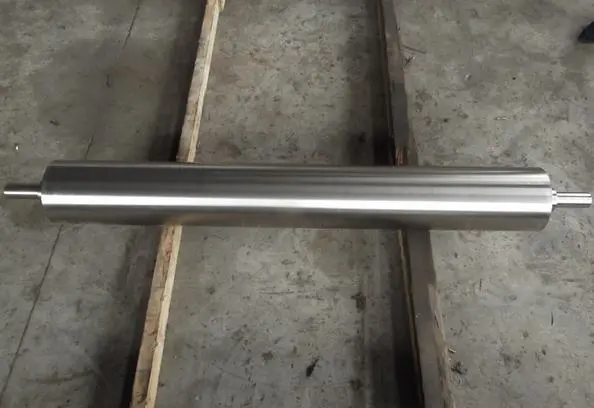Understanding Stabilizer Roll Design and Materials
Core Components of Stabilizer Rolls
Stabilizer rolls are engineered with precision to maintain consistency in various industrial processes. The core components typically include:
- A robust steel shaft that provides structural integrity
- A specially designed outer shell or sleeve, often made from materials like stainless steel or composite materials
- Bearings that allow for smooth rotation and precise alignment
- Surface coatings or treatments to enhance durability and functional properties
These components work in harmony to ensure the roll can withstand the rigors of continuous operation while maintaining its critical stabilizing function.
Material Selection for Thermal Stability
The choice of materials for stabilizer rolls is paramount in managing thermal effects. Engineers consider several factors when selecting materials:
- Coefficient of thermal expansion (CTE): Materials with low CTE are preferred to minimize dimensional changes due to temperature fluctuations
- Thermal conductivity: This property affects how quickly heat is distributed throughout the roll
- Heat capacity: Materials with higher heat capacity can absorb more thermal energy without significant temperature change
- Mechanical properties at elevated temperatures: The material must maintain its strength and stiffness across the operational temperature range
Advanced alloys and composite materials are often utilized to achieve an optimal balance of these properties, ensuring the stabilizer roll remains effective under varying thermal conditions.
Surface Treatments and Coatings
To further enhance the thermal performance of stabilizer rolls, various surface treatments and coatings can be applied:
- Thermal barrier coatings: These can help insulate the roll core from extreme temperatures
- Wear-resistant coatings: These protect the roll surface from abrasion and extend its lifespan
- Corrosion-resistant treatments: These are essential for rolls used in harsh chemical environments
- Non-stick coatings: These prevent material buildup on the roll surface, which can affect thermal transfer
These surface modifications not only improve the roll's resistance to thermal effects but also enhance its overall functionality and durability in demanding industrial applications.
Thermal Effects on Stabilizer Roll Performance
Dimensional Changes and Alignment Issues
Temperature variations can lead to significant dimensional changes in stabilizer rolls, which can have cascading effects on their performance:
- Thermal expansion can cause the roll diameter to increase, potentially altering the nip pressure and contact area with the processed material
- Uneven heating across the roll length may result in thermal bowing, leading to misalignment and uneven pressure distribution
- Changes in bearing clearances due to thermal expansion can affect the roll's rotational accuracy and smoothness
These dimensional changes can compromise the roll's ability to maintain uniform tension and flatness in the processed material, potentially leading to quality issues in the final product.
Surface Texture and Friction Changes
The surface characteristics of stabilizer rolls are critical to their functionality, and temperature variations can induce changes that affect performance:
- Thermal cycling can cause micro-cracks or surface roughness changes, altering the roll's friction characteristics
- Extreme temperatures may affect the properties of surface coatings, potentially leading to adhesion issues or coating degradation
- Thermal expansion differences between the roll core and surface materials can induce stress, potentially causing surface deformation or peeling
These surface changes can impact the roll's ability to grip and guide the processed material effectively, potentially leading to tracking issues or surface defects in the product.
Impact on Bearing Performance and Lubrication
The bearings that support stabilizer rolls are sensitive to temperature changes, which can affect overall roll performance:
- Temperature fluctuations can alter bearing clearances, potentially leading to increased vibration or misalignment
- Extreme temperatures can affect lubricant viscosity, potentially compromising bearing protection and increasing wear
- Thermal cycling can induce stress in bearing components, potentially leading to premature failure or reduced service life
Maintaining proper bearing function is crucial for the smooth and precise operation of stabilizer rolls, making temperature management a critical aspect of roll maintenance and operation.
Strategies for Mitigating Temperature-Related Issues
Temperature Control Systems
Implementing effective temperature control systems is crucial for maintaining optimal stabilizer roll performance:
- Internal cooling systems: Circulating temperature-controlled fluids through the roll core to regulate its temperature
- External cooling/heating systems: Using air or liquid sprays to manage the roll surface temperature
- Infrared temperature monitoring: Real-time temperature mapping to detect and address hotspots or uneven heating
- Automated temperature adjustment: Systems that dynamically adjust cooling or heating based on continuous temperature measurements
These systems help maintain consistent roll temperature, reducing the impact of environmental variations on roll performance.
Material Innovations and Advanced Coatings
Ongoing research and development in materials science offer new solutions for temperature-resistant stabilizer rolls:
- Composite materials with tailored thermal expansion properties
- Ceramic coatings that provide excellent thermal insulation and wear resistance
- Shape memory alloys that can compensate for thermal expansion effects
- Nano-engineered surfaces that maintain consistent friction properties across a wide temperature range
These innovations help create stabilizer rolls that are more resilient to temperature variations, ensuring consistent performance in challenging industrial environments.
Operational Best Practices
Implementing proper operational procedures can significantly mitigate temperature-related issues:
- Gradual warm-up and cool-down procedures to minimize thermal shock
- Regular alignment checks and adjustments to compensate for thermal expansion effects
- Optimized production scheduling to minimize extreme temperature swings
- Continuous monitoring and predictive maintenance to address potential issues before they impact production
By adopting these best practices, manufacturers can extend the life of their stabilizer rolls and maintain consistent product quality despite temperature variations in the production environment.
In conclusion, understanding and managing the effects of temperature variations on stabilizer roll functionality is crucial for maintaining product quality and production efficiency in various industries. By implementing advanced temperature control systems, utilizing innovative materials and coatings, and following best operational practices, manufacturers can significantly mitigate the impact of thermal fluctuations on their stabilizer rolls. This proactive approach not only ensures consistent performance but also extends the service life of these critical components, ultimately contributing to improved product quality and reduced downtime. For more information on how to optimize your stabilizer roll performance in challenging thermal environments, please contact our team of experts at info@welongpost.com.
References
- Overcoming Common Challenges in Roll Forming Production: A Guide to Efficiency and Precision. Super Roll Forming. (2024, November 7).
- Thermal safety characteristics of nanoscale nitrocellulose/stabilizer composite materials. Cellulose. (2024, October 9).
- Enhancing Predictive Maintenance in the Industrial Sector: A Comprehensive Approach. AIP Conference Proceedings. (2024, December 23).
- What is the Roll Forming Process? Machine Matcher. (2024, September 29).
- Predictive Maintenance and The Smart Factory. Deloitte US. (n.d.).
- Spherical Roller Bearings: Uses, Dimensions, Advantages. PIB Sales. (2025, January 9).




